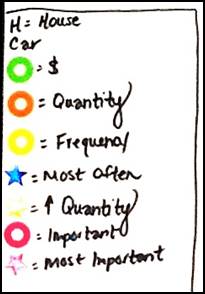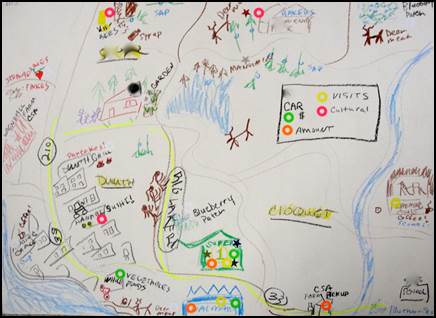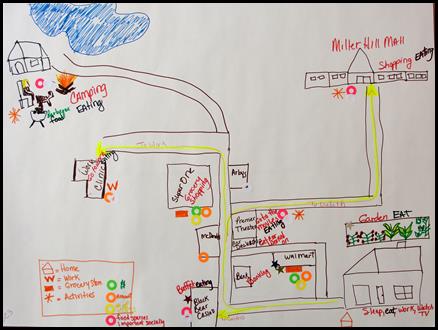 |
December 2014
|
December 2014 // Volume 52 // Number 6 // Ideas at Work // v52-6iw5
Personal Food System Mapping
Abstract
Personal food system mapping is a practical means to engage community participants and educators in individualized and shared learning about food systems, decisions, and behaviors. Moreover, it is a useful approach for introducing the food system concept, which is somewhat abstract. We developed the approach to capture diversity of personal food systems within a community food system and to better understand how it might inform program development. We found mapping to be a useful tool with beneficial applications outside our intended domain. Aggregated map data also provided a useful approximation of the community food system.
Introduction
Since 2008, University of Minnesota Extension and the Fond du Lac (FDL) Reservation community have partnered on projects and programs related to natural resources, food, and health (e.g., Wilsey and Beaulieu, 2010). Our early efforts in food system interventions suggested a disconnect between "external" food system appraisals and the "internal" experiences, needs, and preferences of system participants. Working within a multi-actor collaboration, we developed and implemented a personal food system mapping protocol to explore program development potential at the intersection of health, natural resources, and economic development. We found the protocol effective in its intended use and discovered additional value when used in a different way, as an educational tool. This article briefly describes the personal food system mapping protocol and its application in two different, though complementary, ways.
In a 1999 article on community mapping, Bodeen and Hilliker (1999) outlined a three-step process: familiarization, actual mapping, and then sharing of big ideas. They emphasized a holistic assessment of what exists, or is offered by public or private community actors, an approach frequently taken in food system mapping efforts. This approach is valuable for relatively homogeneous systems, but does not necessarily provide insights when specific user activities are diverse, but limited with respect to the complete system. We anticipated that a key to developing successful program interventions might be the differences between what actually exists (holistic) and what users perceive (individualized). We designed a participatory approach to mapping personal food systems and found it to be practical for learning about individuals' food systems, decisions, and behaviors, and useful for introducing a complex and somewhat abstract concept to community members and educators. Conveniently, we found that our aggregated data also provided a useful approximation of the holistic community food system.
Applications
The protocol asks participants to represent their personal (or household) food system. Participatory mapping works best when participants construct their own reality rather than beginning with an imposed structure (Corbett, 2009), so each individual begins with a blank page and a variety of drawing tools (colored pencils, markers) and color-coded stickers. First, participants begin by creating a basic map depicting important places in their lives. Adequate time is provided for reflection on the features that define an individual's sense of place. Next, a sequenced protocol prompts addition of places where food is obtained or consumed and places associated with food in other meaningful ways. Then, a facilitated process has participants use color-coded stickers to indicate locations of particular importance: places where the most money is spent on food, places where the greatest amount of food is obtained, places most frequently visited for food, and places of social or cultural importance related to food (Figure 1; Figures 2a,b). Throughout, time is provided to allow participants to add and revise as needed.
Figure 1.
Example of a Map Key

Figure 2a.
A Sample Food System Map

Figure 2b.
A Sample Food System Map

Participants then indicate, via another set of stickers, the single "most important" venues within each of the above themes. Finally, participants are asked to indicate important places that relate to food but that were not tagged via the processes detailed above. To conclude, participants have time to openly reflect on the process and to share any insights or ideas.
Community
We used personal food system mapping at FDL as part of a larger, collaborative project to explore program development at the intersection of health, natural resources, and economic development. Previous food system efforts—including a garden distribution program and a micro-CSA (community supported agriculture)—suggested a need for greater understanding of individualized food systems. Also, we saw potential for the process to help our team identify groups with similar systems or behavior patterns (i.e., target audiences) and identify gaps in infrastructure, education, or resources that might suggest, or eliminate, specific programmatic interventions. We developed the mapping protocol to be an accessible and engaging data collection activity that conferred benefits on the participants as well as the project team. The resulting maps (e.g., Figure 2 a, b) highlighted insightful differences between individuals' perceived food systems and the community food system.
Educators
Following the successful community-based application of the personal food system mapping protocol, we applied it with a cohort of Extension Community Nutrition Educators (CNEs). CNEs provide nutrition education directly to low-income audiences in partnership with social service agencies, schools, and other community partners. Generally, they have limited training in policy, systems, and environmental change around food. Here, the personal food system mapping activity was intended to help CNEs to engage with the food system concept and to think about complex food decisions and habits from a community perspective. The community perspective is valuable to CNEs in integrating multi-level public health strategies with nutrition education, so that the education can be made as relevant as possible to participants' actual circumstances. A strong food systems perspective better positions CNEs to consider and address the role of policy, systems, and environmental change in improving health outcomes.
Insights
We found the method to be useful as intended, highlighting diverse food system experiences. We also found personal food system mapping to be an effective means for researchers and participants to converge upon a shared understanding of the food system concept. In both applications, engaging the food system concept from an individual perspective seemed to unlock greater understanding of the more abstract community food system construct. Finally, the personal food system mapping seemed to help individuals gain insight into their own behaviors, by clarifying patterns related to food acquisition, allocation of time and financial resources, and travel habits, as well as (mis) alignment of behaviors and personal values.
Conclusions
Personal food system mapping represents one effective approach to engaging food system actors in the development of food system interventions. The power of this or any approach to developing meaningful interventions resides in a few underlying principles: participation, intentional development of a shared understanding among actors, and recognition that a singular portrayal of complex systems often masks diversity. Finally, the application of the participatory mapping tool outside of its initial context reinforces the idea that creative adaptation of good tools represents a bottomless resource for Extension professionals as they encounter new and different challenges.
Acknowledgements
The personal food system mapping approach emerged from the collaborative food systems work with the FDL community. It was developed by a team that included the authors and the following individuals: J. Bennett, C. Diver, D. Diver, S. Hamid, B. Johnson, N. Sandman, and A. Walsh, with facilitation by D. Newman. The FDL food system project was supported through financial and other contributions from the FDL Band of Lake Superior Chippewa and University of Minnesota Extension.
References
Corbett, J. (2009). Good practices in participatory mapping: A review. Prepared for the International Fund for Agricultural Development (IFAD): Rome, Italy. Retrieved from: http://www.ifad.org/pub/map/pm_web.pdf
Bodeen, C., & Hilliker, M. (1999). Community mapping exercises provide enhanced participant interaction in visioning processes. Journal of Extension [On-line], 37(6) Article 6TOT1. Available at: http://www.joe.org/joe/1999december/tt1.php
Wilsey, D., & Beaulieu, S. (2010). We listen to them: Assessing Natural Resource Perspectives and Priorities in a Tribal Community. Journal of Extension [On-line], 48(5) Article: 5FEA9. Available at: http://www.joe.org/joe/2010october/a9.php




